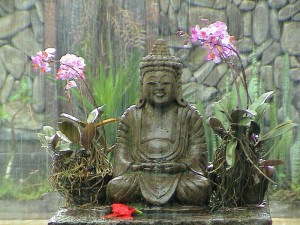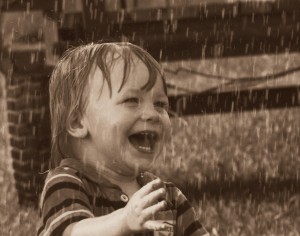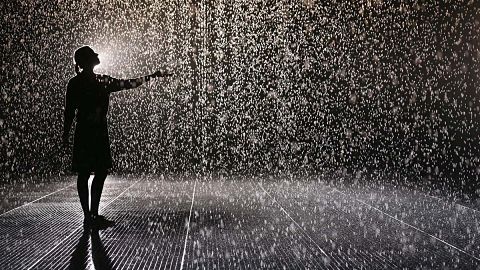An overcast day conveys an admixture of somberness and beauty. There were two brief showers, the first in many weeks in California’s Central Valley.
 The initial shower lasted only a minute as I walked into the parkland from the gated upper end. I happened to be passing a man as the rain began to fall, and we walked alongside each other in silence. We were like two strangers receiving a brief, unexpected downpour in a desert—which is close to the truth in more ways than one.
The initial shower lasted only a minute as I walked into the parkland from the gated upper end. I happened to be passing a man as the rain began to fall, and we walked alongside each other in silence. We were like two strangers receiving a brief, unexpected downpour in a desert—which is close to the truth in more ways than one.
“That was strange,” the fellow commented when the small shower was over. Yes, but rather nice, I replied. He smiled and nodded in agreement, and we went our separate ways.
The second shower came after a splendid hour doing nothing beside the stream but the most important thing: Listening and watching without reaction to the movement outside and inside, until there is no separation between outside and inside.
The parkland was redolent of earth as weeks of dust and dirt were washed from the foliage, and the parched land got its first taste of seasonal replenishment. It would take longer and stronger rains to rinse the land clean, and by then the leaves will be falling.
Though I only had t-shirt on, I didn’t mind the steady shower a bit. In fact after being unburdened by a state of negation initiated in meditation, the body felt even lighter and quicker.
My sittings in nature begin with a period of disciplined but unforced and enjoyable watchfulness beside the stream. Awareness quickens and gathers with passive observation into an intensity of attention. Spontaneously, and always surprisingly, a lineless boundary is crossed from the linear dimension of thought, with its random associations and useless chatter, to silence and stillness, in which psychological time ends without goal or effort.
‘Guided meditation’ is a complete contradiction in terms; if meditation is guided, by your guru or by your self, it precludes meditation. Attention in meditation is completely undirected. Instructions like “take your attention to the top of your head” are ridiculous, because in meditation attention gathers and acts unseen, not from the top of one’s head or from the center and self.
So what is the movement of attention, if it’s undirected and unwilled, and not from the center, the ‘I?’ The mind and self have one capability—concentration. We can focus our minds and do tremendous things, from designing the most complex rockets and computers, to devising constitutions that formerly formed the foundations of nations.
But concentration has no place in meditation, since it is the action of the very mind one wants to quiet. Listening to some soothing voice telling you how to breathe and where to ‘direct your attention’ puts the mind to sleep; it doesn’t awaken it. Guided meditation is really a form of group hypnosis.
to some soothing voice telling you how to breathe and where to ‘direct your attention’ puts the mind to sleep; it doesn’t awaken it. Guided meditation is really a form of group hypnosis.
Attention is an intensity of awareness of what is actually happening within oneself in the moment, and one cannot fabricate that intensity. Attention to what is—to sensations, thoughts and emotions as they arise—is the only action that changes what is, and quiets thought and ends the separation of self. But what, if not ‘me,’ gathers the attention that quiets thought?
Passive observation and watchfulness, listening for its own sake without judging or naming, is what allows the brain to gather attention negatively, unseen by the controlling mind. Attention then acts on its own, without will or direction, without guidance or goal, to quiet the mind-as-thought, which is based on memory and association.
The attention of meditation is like a cleansing downpour over which one has no control, not an intended action of the self. Intent matters, but intention has no place. In the simplest terms, intent is an expression of the heart, whereas intention is an objective of the mind. Having a goal prevents the phenomenon of meditation from happening.
It’s not only possible, it’s imperative to watch without the watcher, to listen without the listener. The brain has the capacity for an action that does not emanate from the self and is not mediated by the intellect.
Attention is this capacity. It’s a completely different action than concentration, without implying any separation. (We can make distinctions without adding to separation.)
 Thinking has its place, and there may even be thinking without a thinker, but thinking has to be set aside completely for the phenomenon of meditation to occur. As a person with a philosophical bent (in both senses of the word perhaps), I know how difficult that can be, but to my mind, it has to be done each day if one wants to grow as a human being.
Thinking has its place, and there may even be thinking without a thinker, but thinking has to be set aside completely for the phenomenon of meditation to occur. As a person with a philosophical bent (in both senses of the word perhaps), I know how difficult that can be, but to my mind, it has to be done each day if one wants to grow as a human being.
Taking an attitude of experimentation and play with observation, watching the mind and emotions with dispassionate curiosity, not from the illusory separation as the observer and ‘me,’ makes all the difference. Let one’s mental/emotional chaos be, watching it like a hawk, and the mind and heart will unfold and tell their story, painful as it may be.
When one learns how to observe without the observer, and makes the space daily to sit quietly, attention gathers unseen and acts undirected, quieting the mind and opening the heart. There is no path, no method, no technique, and no tradition. Negation is the way to peace, and bliss.
The more intense the meditative experience, the more important it is to let it go. Nothing is permanent, so let go of whatever happens. Keep a journal if you’re inclined to as I am, but don’t install meditative events in the scrolls of memory, or one will become caught in comparison and effort to repeat and extend peaceful and ecstatic states. Remembering and comparing prevent meditation from occurring anew, and deepening, which is spiritual growth.
Inward growth only happens through negation, never through addition. Short of illumination, that’s a lesson we all have to keep re-learning, since the very essence of the mind, as we usually know it, is to grasp, hold and accumulate experiences, things, power, etc.
To stand completely alone inwardly, even a few times for a few timeless minutes during the week, is a tremendous thing.
Martin LeFevre

